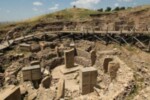Abstract
The oldest evidence and records of catastrophic falls of large space rocks are undoubtedly impact craters that are studied by geologists. However, in historical times, i.e. the times of the emergence and development of human cultures, there are also records discovered by the latest geological but also archaeological research. Among the most spectacular are the discoveries of Chinese archaeologists. They link the invention of stone tools made on both sides (including fists and hatchets) almost 800,000 years ago in the area of the Bose Valley in Guangxi in southern China with the decline of tektites in the Middle Paleolithic. With the development and invention of writing, they are also reflected in sculptures, written texts, poems, notes and chronicles. Scientists believe that rock-carved symbols found in the world’s oldest temple, Göbekli Tepe in southern Turkey, dated to over 10,000 BC, are evidence that a comet caused the Little Ice Age. Also worth mentioning is the Epic of Gilgamesh, which is probably the oldest written story on Earth. Originally from ancient Sumeria, it was written in cuneiform on 12 clay tablets. It follows the adventures of the historical king of Uruk, somewhere between 2750 and 2500 BC. According to the translated text of the recently discovered new cuneiform tablets, on the so-called In the first Tablet, there is a record of a large meteorite that fell to the ground. However, the destruction of Sodom and Gomorrah described in the Bible, as recent research has shown, is also the result of a cosmic body that fell in this region of Jordan.
Introduction
The oldest evidence and records of catastrophic falls of large cosmic rocks are undoubtedly impact craters, which are studied by geologists.
In historical times, i.e. the time of the emergence and development of human cultures, there are also records constituting not only geological but also archaeological discoveries. The most spectacular are the discoveries of Chinese archaeologists. They associated the discovery almost 800 thousand years ago, in the Bose Valley in Guangxi in southern China, stone tools made on both sides (including fists and axes), with a decline in tektites in the Middle Paleolithic (Yang et al. 2020).
The invention and development of writing was reflected in sculptures, written texts, poems, notes and chronicles. Scientists believe that rock-carved symbols found in the world’s oldest temple, Göbekli Tepe in southern Turkey, which dates back to more than 10,000 BC, are evidence that a comet caused the Little Ice Age (MacDonald 2019). The Epic of Gilgamesh is also worth mentioning, and is probably the oldest written story on Earth. It comes from ancient Sumeria, where it was originally written in cuneiform on 12 clay tablets. It tells the story of the adventures of the historical king of Uruk, who lived somewhere between 2750 and 2500 BCE. According to the translated text of recently discovered new cuneiform tablets, the so-called First Tablet contains a record of a large meteorite that fell to Earth (Kotowiecki 2022a). On the other hand, the destruction of Sodom and Gomorrah described in the Bible, as recent research has shown, is also the result of a cosmic body falling in this region of Jordan (Johnston 2021).
Bose Valley in Guangxi, China
Did the fall of a large number of tektites contribute to the civilizational leap of ancient hominids? According to recent archaeological and geological research, the answer is yes. It should be emphasized that Chinese archaeologists associate the invention of double-sided stone tools (so-called fists and axes) almost 800 thousand years ago in the Bose Valley in Guangxi, southern China, with the fall of tektites in the Middle Paleolithic (Michel et al. 2021). The Bose Basin in Guangxi, southern China, is well known for the presence of double-sided Paleolithic tools. The Bose Basin handaxes have attracted the attention of the international scientific community, primarily for two reasons – first, their age of 803 thousand years, which indicates the transition from the Early to the Middle Pleistocene, and second, the presence of bilaterally – unmade stone tools, the so-called fists (Michel et al. 2021). However, doubts arose almost immediately, because the age of these tools was based on their alleged association with Australian tektites. Therefore, the question arose as to when these tools could have been deposited in the ground. During the first research, all the axes from the Bose Basin were collected from the surface. An important element of the expert assessments was the question of whether they could be associated with tektites.
The results of the analysis from the latest excavations from the Fengshu dao site in the Bose Basin confirmed this. Both the tektites and the axes come from the same stratigraphic level and from the same site. Additionally, they indicate that the age of these stone tools is about 803 thousand years (Yang et al. 2020). Tektites found in the Australo-Asian region are 803,000±3,000 years old and are from the same period as the oldest known large cutting tools, the so-called indexable cutting tools (LCT) in East Asia. These stone artifacts, along with the technique of their processing, later spread throughout Eurasia, and Africa. Scientists Wei Wang, Christopher J. Bae, Shengmin Huang and others suggest that the direct cause of this technological advance in East Asia was the impact of a large meteoroid, which resulted in tektites and the associated catastrophic fires (Wang et al. 2014). These fires led to the burning of forests in areas inhabited by hominids, which is why they started to produce this type of improved stone tools (Kotowiecki 2022b).
Göbekli Tepe, Turkey
Göbekli Tepe – “Belly Hill”; is known as Gir)e Mirazan or Xirabreþk)e in Kurdish. It is a Neolithic archaeological site near the city of anlýurfa in southeastern Anatolia, Turkey. It has been dated to even more than 10,000 BC (Curry 2008). The site consists of many large circular structures supported by massive stone pillars and these are the oldest known megaliths in the world. Many of these supports are richly decorated with abstract details, costumed figures, and bas-relief carvings of wild animals, providing archaeologists with a rare insight into prehistoric religion and the particular iconography of this period. Much of the symbolism at Göbekli Tepe has been interpreted in terms of astronomical events. By adjusting the flat relief on some pillars at Göbekli Tepe, scientists found convincing evidence that, for example, the famous „vulture stone” is dated to 10,890±250 BC, which corresponds closely to the proposed Younger Dryas glaciation event (Younger Dryas – YDIH), estimated at 10,890 B.C. (Knapton 2017).
The Clovis and comet onset hypotheses postulate that fragments of a large, 4 km in diameter, disintegrating asteroid or comet struck North America, South America, Europe, and western Asia, coinciding with the onset of the glacial and cold periods (MacDonald 2019). Some scientists, such as D.J. Kennett, J.P. Kennett, A.West and others claim that the dust produced during the impact, it floated in the atmosphere and spread on a global scale, thanks why, after falling, it formed a layer with peak concentrations of platinum, high at the temperature of rubber spherules, molten glass and nanodiamonds. This layer visible is the Younger Dryas (YD) boundary layer (YDB). This created isochronous reference base in over 50 places covering approximately 50 million km2 the Earth’s surface (Kennett et al. 2009). Based on scientific research, we suggest -This event was said to have caused extensive biomass burning, a short winter and sudden climate change. It also contributed to the extinction of late Pleistocene megafauna, and also caused the end of the Clovis culture in America (Sweatman 2021).
There is also evidence at Göbekli Tepe that a key function of Göbekli Tepe were supposed to be observations of astronomical phenomena. The flat carvings on the pillar of the structure known as the Vulture Stone depict animals in characteristic positions. These symbols puzzled many researchers for a long time until Martin Sweatman and his team discovered that they corresponded to star constellations and showed how a swarm of comets hit the Earth (Sweatman et al. 2017). The pillar also bears the image of a decapitated man, which is considered to be a symbol of human catastrophe and the many casualties that followed the impact. These studies, together with the recent discovery of an anomaly known as extensive platinum deposits in North America, have, according to Martin Sweatman, principal investigator at the School of Engineering at the University of Edinburgh, weighed in favour of a cometary impact during the Younger Dryas. In his opinion, the inhabitants of Gobekli Tepe were particularly interested in the Taurid meteor stream, the same meteorite that is probably responsible for the Younger Dryas catastrophe. The dating of the Göbekli Tepe sculptures also aligns with information from drill cores extracted in Greenland, which indicate that the Younger Dryas period began around 10,890 BCE.
Sodom and Gomorrah, Jordan
According to the biblical Book of Genesis, the city of Sodom was destroyed by God due to the wickedness of its inhabitants. However, there are several historical sites that could have been Sodom. Some scientists have suggested that the city may have been destroyed by a natural event (Bergoeing 2018). However, this hypothesis was widely considered science fiction. It was not until geologist Sid Mitra of East Carolina University in the USA, and his colleagues, discovered and probably found an explanation for where Sodom was located and what happened to it (Bunch et al. 2022). He focused his attention on a Middle Bronze Age city called Tallel-Hammam, which is located in the Jordan Valley (Johnston 2021). In 2005, archaeologists discovered a 1.5-meter-thick layer of rubble and destruction at this site, consisting of materials exposed to intense heat. Archaeologists found evidence of a high-temperature fire, reaching in some places over 1,700°C. The technology available to people in the Bronze Age did not allow for such high temperatures to be generated. Scientists from various disciplines, including geology, physics, and chemistry joined forces to examine artifacts found at the site. Much of the organic carbon at Tall el-Hammam was found to be in the form of soot, indicating high-temperature combustion that could only have been caused by an asteroid impact. Evidence examined by the researchers also included diamond-like carbon, fused ceramics, and other materials affected by high temperatures and pressure shock. Fused quartz grains and trinitite-like materials were found at the site (Bunch et al. 2022). Archaeologist Sid Mitra has also hypothesized that this catastrophic event, 3,600 years ago, may have been recorded in local oral traditions and then not made it into the Bible. The event may also explain why the region around Tall el-Hammam was abandoned for many years. Archaeologists have also found high salt concentrations in the site’s „destruction layer,” which is likely the result of an asteroid falling into or striking the Dead Sea shoreline. The explosion may have spread salt over a wide area, creating a highly saline soil that prevented crops from growing and led to the abandonment of cities along the Jordan Valley for centuries (Gershon 2021).
The Epic of Gilgamesh, Iraq
I have written several articles on the history of the oldest texts describing meteorites, as well as monuments made from meteorites and tektites (Kotowiecki 2004). For this reason, I should mention the overlooked and silenced description of a meteorite in the oldest written text on Earth. I came across this description by accident while translating recently discovered new tablets from English with the record of the Epic of Gilgamesh. Although the event related to the meteorite takes place in the conversations and dreams of the main character, the aforementioned text is the first and oldest record of the fall of a cosmic rock. The epic is considered a fundamental work in religion and the tradition of heroic sagas, with Gilgamesh being the original model for later heroes, such as Hercules. The work itself had a great influence on the Homeric epics. It should be noted at the outset that the tablets on which the text is written are crumbled in places, there are many gaps and the end of the text is practically missing. Despite this, the whole is still clear (Kotowiecki 2022a). Let us recall that Austen Henry Layard discovered about 15,000 fragments of Assyrian cuneiform tablets in the Library of Ashurbanipal in Nineveh. At the end of the next decade, the British Museum employed George Smith to study them. In 1872 Smith read the translated fragments before the Society of Biblical Archaeology, and in 1875 and 1876 he published a fuller translation, most recently published as The Chaldean Account of Genesis (George 2017). In 1891 Paul Haupt collected the cuneiform text, and nine years later Peter Jensen provided a comprehensive edition. R. Campbell Thompson updated both works in 1930. Over the next two decades Samuel Noah Kramer recollected the Sumerian poems. In 1998, the American Assyriologist Theodore Kwasman discovered a work in a British Museum warehouse that was believed to contain the first lines of the epic. It was a fragment, found in 1878 and dated to between 600 and 100 BCE, that had remained unexamined by experts for over a hundred years after its discovery. The fragment read: The discovery of artifacts from around 2600 BCE associated with Enmebaragesim of Kish, who is mentioned in legends as the father of one of Gilgamesh’s opponents, has given credence to the historical existence of Gilgamesh. Thus, the full text has only recently been known and confirmed to us (Kotowiecki 2022a).
Conclusion
To sum up, the latest geological and archaeological research brings more and more interesting discoveries related to cosmic bodies that fall to Earth. As it turns out, cosmic catastrophes changed history and influenced the development of humanity (Kotowiecki 2022a). In old chronicles and legends, we often encounter mentions of various stones that fall from the sky. It should also be emphasized that in the past, the discovered rocks, which did not resemble earthly rocks in any way, became objects of great worship or were used to produce jewelry, weapons or utility items (Kotowiecki 2004). In the long history since antiquity, they were also the property of temples, rulers, shamans, magicians, charlatans and fraudsters. Meteorites were also the subject of religious beliefs, punishment or a gift from God or a magical or medical remedy (Kotowiecki 2003). Meteorites’ falls were observed with concern. I wonder what other discoveries related to meteorites await us in archaeology?
References:
Bergoeing J.P., 2018, Sodom and Gomorrah and Plates Tectonic, Mercator, 17(1), s. 1–9.
Bunch T.E., LeCompte M.A., Adedeji A.V., Wittke J.H., Burleigh T.D., Hermes R.E., Mooney Ch., Batchelor D., Wolbach W.S., Kathan J., Kletetschka G., Patterson M.C.L., Swindel E.C., Witwer T., Howard G.A., Mitra S., Moore Ch.R., Langworthy K., Kennett J.P., West A., Silvia P.J., 2021, A Tunguska sized airburst destroyed Tall el-Hammam a Middle Bronze Age city in the Jordan Valley near the Dead Sea, Scientific Reports, article number: 18632 (2021).
Kotowiecki A., 2003, Święte meteoryty, Meteoryt, 3, s. 26–28.
Kotowiecki A., 2004, Artifacts in Polish collections made of meteoritic iron, Meteoritics & Planetary Science, 39(S8), s. A151–A156.
Kotowiecki A., 2022a, Meteoryt w Eposie o Gilgameszu, Meteoryt, 102, s. 14–15.
Kotowiecki A., 2022b, Tektyty i szkliwo impaktowe w świetle badań i odkrych archeologicznych na świecie, Acta Societatis Metheoriticae Polonorum, 13, s. 60–66.
Michel V., Feng X., Shen G., Cauche D., Moncel M-H., Gallet S., Gratuze B., Wei J., Ma X., Liu K., 2021, First 40Ar/39Ar analyses of Australasian tektites in close association with bifacially worked artifacts at Nalai site in Bose Basin, South China: The question of the early Chinese Acheulean, Journal of Human Evolution, 153, doi:10.1016/j.jhevol.2021.102953
Sweatman M.B., Tsikritsis D., 2017, Decoding Göbekli Tepe with Archeoastronomy: What does The Fox Say?, Mediterranean Archaeology and Archaeometry, 17(1), s. 233–250.
Sweatman M.B., 2021, ‘The Younger Dryas impact hypothesis: review of the impact evidence’, Earth-Science Reviews, vol. 218, 103677, doi:10.1016/j.earscirev.2021.103677
Wang W., Bae C.J., Huang S., Huang X.,Tian F., Mo J., Huang Z., Huang C., Xie S., Li D., 2014, Middle Pleistocene bifaces from Fengshudao (Bose Basin, Guangxi, China), J. Hum. Evol., 69, s. 110–122, doi:10.1016/j.jhevol.2013.11.002
Yang S.X., Deng C.L., Zhu R.X., Petraglia M.D., 2020, The Paleolithic in the Nihewan Basin, China: Evolutionary history of an Early to Late Pleistocene record in Eastern Asia, Evol Anthropol., 2020 May; 29(3), s. 125–142, doi:10.1002/evan.21813
Internet sources:
Carnahan W., 1998, The Epic of Gilgamesh Translated by Maureen Gallery Kovacs Electronic, https://uruk-warka.dk/Gilgamish/The%20Epic%20of%20Gilgamesh.pdf (Access 06-04-2023)
Curry A., 2008, Gobekli Tepe: The World’s First Temple?, Predating Stonehenge by 6,000 years, Turkey’s stunning Gobekli Tepe upends the conventional view of the rise of civilization, Smithsonian Magazine
Geoge A., 2017, The Epic of Gilgamesh, A New Translation, Publisher: Penguin Classics.
Gershon L., 2021, Ancient City’s Destruction by Exploding Space Rock May Have Inspired Biblical Story of Sodom, Smithsonian Magazine.
Johnston H., 2021, Meteor strike may have destroyed Sodom, collective blob motion, asteroid nuclear impact, portal PhysicsWorld.
Kennett D.J., Kennett J.P., West A., Mercer C., Que Hee S.S., Bement L., Bunch T.E., Sellers M., Wolbach W.S., 2009, Nanodiamonds in the Younger Dryas boundary sediment layer, portal Science
Knapton S., 2017, Ancient stone carvings confirm how comet struck Earth in 10,950BC, sparking the rise of civilisations, portal The Telegraph.
MacDonald F., 2019, Ancient Carvings Show Evidence of a Comet Swarm Hitting Earth Around 13,000 Years Ago, portal Science Alert.
This article was first Publish – A.Kotowiecki – Najstarsze dowody archeologiczne i relacje tekstowe o różnych spadkach skał z kosmosu w najstarszej historii ludzkości – (The oldest archaeological evidence and textual accounts of various rock falls from space in the oldest human history), Acta Soc. Metheor. Polon., 14, 2023, s. 86-92. https://bibliotekanauki.pl/articles/2195007
Additional sources:
1. Kotowiecki A., Meteorite in the Epic of Gilgamesh, https://pressmania.pl/meteorite-in-the-epic-of-gilgamesh/#
2. Kotowiecki A., W Göbekli Tepe są zapisy upadku komety i meteorytów, https://pressmania.pl/w-gobekli-tepe-sa-zapisy-upadku-komety-i-meteorytow/
3. Kotowiecki A., Tajemniczy krater Hiawatha na Grenlandii ma jednak 58 milionów lat, https://pressmania.pl/tajemniczy-krater-hiawatha-na-grenlandii-ma-jednak-58-milionow-lat/
About the author: Andrzej Kotowiecki
Born in Wadowice in 1954. A lawyer by education, studies at the Jagiellonian University, a prosecutor by profession, a passionate historian, archaeologist, geologist, paleontologist, religious expert, collector and traveler. Founding member of the Polish Meteorite Society.












Zostaw komentarz